From Ground to Sky: The Evolution of Satellite Telecommunications Technology
The evolution of satellite telecommunications technology has revolutionized the way we communicate, enabling global connectivity and transforming industries. This article explores the history and development of satellite telecommunications, from its humble beginnings to the cutting-edge technology of today.

From Ground to Sky: The Evolution of Satellite Telecommunications Technology
From Ground to Sky: The Evolution of Satellite Telecommunications Technology has been a remarkable journey, marked by significant milestones and innovations that have transformed the way we communicate. The evolution of satellite telecommunications technology has enabled global connectivity, bridging the gap between remote and urban areas, and has had a profound impact on various industries, including telecommunications, navigation, and weather forecasting.
The concept of satellite telecommunications dates back to the 1940s, when scientist Arthur C. Clarke proposed the idea of using satellites in geostationary orbit to relay communications signals. However, it wasn’t until the 1960s that the first commercial satellite, Intelsat 1, was launched, marking the beginning of a new era in telecommunications. Since then, satellite technology has continued to evolve, with advancements in materials, design, and launch systems enabling the development of more efficient, reliable, and cost-effective satellites.
Early Years of Satellite Telecommunications
The early years of satellite telecommunications were marked by significant challenges, including limited bandwidth, high latency, and signal degradation. However, despite these challenges, satellites played a crucial role in connecting remote and underserved areas, where traditional telecommunications infrastructure was lacking. The introduction of geostationary satellites, which remain stationary in the sky, enabled the provision of continuous coverage and connectivity, further expanding the reach of satellite telecommunications.
One of the key milestones in the evolution of satellite telecommunications was the launch of the first mobile satellite communications system, Inmarsat, in 1979. Inmarsat enabled global mobile communications, facilitating voice and data transmission between ships, aircraft, and remote areas. This marked a significant turning point in the development of satellite telecommunications, as it enabled the provision of mobile services and expanded the reach of satellite connectivity.
Modern Satellite Telecommunications Technology
Today, satellite telecommunications technology is more advanced than ever, with the development of high-throughput satellites (HTS), which offer significantly higher bandwidth and faster speeds than traditional satellites. HTS have enabled the provision of broadband services, including internet, voice, and data transmission, to remote and underserved areas, bridging the digital divide and promoting economic development.
Another significant development in satellite telecommunications is the emergence of low-earth orbit (LEO) satellites, which operate at much lower altitudes than traditional geostationary satellites. LEO satellites offer lower latency and higher throughput, making them ideal for real-time applications, such as video conferencing and online gaming. Companies like SpaceX and OneWeb are leading the charge in the development of LEO satellite constellations, which are expected to revolutionize the satellite telecommunications industry.
Future of Satellite Telecommunications
As the demand for satellite telecommunications continues to grow, driven by the increasing need for global connectivity and broadband services, the industry is expected to evolve further. The development of new technologies, such as 5G and quantum communications, is expected to play a significant role in shaping the future of satellite telecommunications. Additionally, the increasing use of satellites in areas like Earth observation, navigation, and weather forecasting is expected to drive growth and innovation in the industry.




